|
The Elegance of Silvered Mercury Glass
By Diane Lytwyn
Silvered mercury glass describes glass that was blown double-walled, then
silvered between the layers with a solution containing silver nitrate in a
liquid formula and sealed.
With its unique mirror surface and sleek silvery
shine, mercury glass is easy to identify and is truly distinct among the many
types of Art glass produced in the 19 century. While virtually silver in
appearance and commonly referred to as "mercury glass," silvered glass has
nothing to do with the precious metal, and mercury was never used in the formula
for tableware.
Although blown glass orbs coated on the inside with
mysterious liquid silvering solutions first appeared in the late 17th century,
the decorative vases, beakers, goblets and tableware known today as mercury
glass were first made around 1840 in the forests of Bohemia, which is now the
Czech Republic. Appearing almost simultaneously in Bohemia, England and the
United States, silvered glass created an instant sensation in the mid-19th
century and was lauded as an important discovery in scientific journals.
Silvered glass was shown at the great Crystal Palace Exhibition held in
London in 1851. The unusual beauty and novel techniques used to create the glass
were praised in several essays from two prominent publications including, "The
Illustrated Catalogue" by the Art Journal and in "Tallis's History and
Description of the Crystal Palace", both of which provided lessons on taste by
leading authorities of that time. Several years later, silvered glass made by
the New England Glass Company was exhibited at the New York Crystal Palace held
in 1853.
Initially a curiosity, silvered glass may have become popular
because of its marked departure from the aesthetic tedium of the clear blown and
pressed glass made in the early 19th century. Sometimes referred to as a
novelty, the production of silvered mercury glass lasted about 80 years.
Although early figural pieces and simple vessels made in Bohemia may have
provided a less expensive alternative to metal ware, the prevailing styles of
mid-19th century coin silver or silver-plated items were in no way comparable to
silvered glass forms and styles. Silvered glass was acquired and collected based
on its unique and inherent artistic value as decorative glass, and not, as often
thought, as a substitute for silver. In fact, silvered glass may rightly be
considered the first true type of art glass.
The double-walled glass vessels
used for silvering were made free-blown and involved the use of a hollow
blowpipe and a long, flat-topped iron tool called a punty rod. After the piece
was blown into it's final shape, the punty rod was attached to the other end of
the object being worked to finish it. After the object was completed, it was
cracked off the punty rod, and the remaining aperture was the route used to
introduce the silvering solution.
Since the glass was blown, there is always
a pontil "scar," which is the mark left after the glass is cracked off the punty
rod during the finishing step. The presence of a pontil scar may be considered
the hallmark of most blown glass, and in cases where the rough edges in this
area were then polished or smoothed, a slight depression or other evidence is
usually visible underfoot.
Created in a wide variety of shapes and styles, silvered mercury glass was
crafted into beakers, compotes, curtain tie-backs, figures, gazing globes,
goblets, pitchers, salts, tableware and vases. Many pieces were subject to an
astonishing variety of decorating techniques, including hand painting,
acid-vapor matting, enameling, etching, engraving, overlay casing cut to silver
and even the application of glass "jewels." Mercury glass can be colorful and
elegant or simple and austere, depending on the maker, and collectors may focus
on a particular shape or decorative style.
For most collectors, mercury
glass made in Bohemia is most often found since great quantities were produced
there from about 1840 to at least 1920. Silvered glass was made in the United
States for about 30 years, from approximately1851 to around 1880. The production
of English silvered glass, however, lasted only about six years, from 1849 to
1855, and examples are difficult to find. Edward Varnish and Fredrick Hale
Thomson of England were granted a joint patent for silvering glass, issued in
1849. These signed pieces are extremely rare, and therefore, highly sought
after.
The discovery of a signed piece is unusual, as most silvered mercury
glass is not marked in any way. In spite of not being marked, it is still
possible to identify the country or origin by a careful examination of the
piece. Attribution can often be established based on determining the type of
glass used and the style of decoration. English and American pieces, made from
flint glass or glass with lead in the formula, are quite heavy for their size,
have thick walls, and a bell-tone resonance when tapped.
Bohemian items are
generally lightweight by comparison. Bohemian glass items were made from glass
that did not contain lead and were blown quite thin. Since the glass could not
endure the cutting wheel for traditional engraving, the Bohemians developed many
other decorating methods, including the granulate application technique.
Granulate application etching is the process whereby crushed or pulverized
quartz crystal, acting like a powder, was applied to the prepared surface with
the use of a design template or stencil. The piece was then re-fired on low heat
to set the pattern. This decorating method is probably unique to silvered
mercury glass, and a myriad of patterns  grapes, grape leaves, tendrils,
flowers, ferns, palms, birds and motifs consistent with the Bohemian forest
style typical of the late 18th and 19th centuries  are found most often. In
addition, the gold wash effect on the interiors of the vast majority of
compotes, beakers, goblets, pitchers, salts and vases were achieved with the use
of chemical stains. The contrast of the gold to silver resulted in a piece of
extraordinary brilliance. It is found on silvered glass made in Bohemia and on
some English pieces, but silvered glass made in the United States, however, was
never gold washed.
Bohemian silvered mercury glass is often found with
bright enamel coloration and gold accents on a frosty satin ground. American
glass was either plain or engraved, while English silvered glass pieces were
cased and cut to silver. Cased glass refers to glass blown with a top overlay
layer of transparent colored glass, which was then cut through to the clear or
silver layer in a variety of geometric patterns. Cased silvered glass, which was
made in England and rarely in other countries, is extremely rare to
find.
While the differences in decorating techniques offer some assistance to
establish attribution, the ultimate clue in the determination of the country of
origin and, in some cases the maker, is found in the type of seal that was used.
Although not completely foolproof, mercury glass pieces from England were
finished with an impressed metal disc covered by a glass wafer, which was
cemented into the polished pontil scar. Many Bohemian items used lead or metal
seals with glass discs, but the pontil was left rough, or sharp-edged. The
Bohemian firm of Hugo Wolf did use a similar seal, and rare pieces with the "HW"
embossed on a metal disc under glass can be found. The sealing methods utilized
in the United States, by comparison, included the use of a simple cork in the
rough pontil scar, or in the case of the New England Glass Company of Cambridge,
Mass., a metal disc impressed with "NEG.Co." covered with a glass disc was used
to seal the piece.
The ability to correctly identify the country of origin
may be exciting for the collector, but it is the variety of shapes, styles and
surface decorations found in silvered glass that compels acquisition and appeals
to many tastes, ranging from formal art glass decorative to historical Americana
and rustic country cottage.
The value of silvered mercury glass depends on
its rarity, condition and quality of design. Beginning collectors may be able to
find simple painted mercury glass vases, usually made in Bohemia and in average
condition, for under $200. The engraved silvered flint glass made in the United
States is more difficult to find and makes up the middle market, while cased or
colored English silvered glass, marked "Varnish" or "Thomson", are rare to
discover and may be priced in the hundreds if not thousands of
dollars.
Silvered mercury glass items found with the original seal are
usually higher priced than pieces with an open pontil scar, or hole, underfoot.
Once the seal is opened or lost, the degree of silvering degradation depends on
atmospheric conditions, and significant flake or patch loss greatly affects the
value. Any chips, cracks or damage to the glass itself, as with other types of
old glass, detracts considerably from appearance and price.
The appeal of
antique silvered mercury glass has contributed to the development of new,
mass-produced items available on today's market. One way to tell the difference
is to examine the bottom. Silvered glass made in the 19th century will always
have some type of seal or opening underfoot, while contemporary items are
smoothed, much like the lining of a thermos bottle. By studying the traditional
decorating methods used, mistakes can be avoided.
Silvered mercury glass is
sold in antique shops, at shows and on-line. Be sure to examine pieces carefully
for damage, and on Internet sites such as eBay, prospective bidders should
always request a photograph of the bottom seal. Descriptions and photographic
images can be deceiving, so ask about condition before you bid or buy.
The
acquisition of fine pieces of silvered mercury glass can pose a challenge for
collectors because surviving examples are not easy to find when compared to
other types of art glass.
Perhaps it is the rarity of the glass itself that
contributes to its allure, but the glittering beauty of this unique antique
glass can offer real aesthetic pleasure to any collector, and investment in this
art glass may well reward the willing, as values are sure to increase in years
to come.
Diane C. Lytwyn is the author of the Pictorial Guide
To Silvered Mercury Glass (Collector Books). A collector for years, Diane has
lectured on the topic of mercury glass and has created the website
www.antiquemercuryglass.com.
|
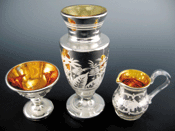
Gold washed, etched mercury glass made in Behemia,
circa 1860-80.
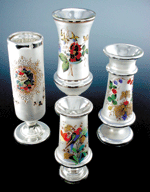
Group of painted enamel decorated vases, 1860-80. Top: Mint vivid enamel
flowers on satin matte ground; right: gold butterfly and florals, hand painted
and cold enamel; bottom: painted Parrot vase, bright color;
left: unusual
lacy raised paste enamel and gold Victorian-style decorations.
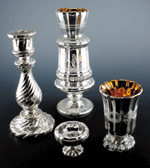
Group of rare blown-molded Bohemian silvered glass pieces, circa 1860-80.
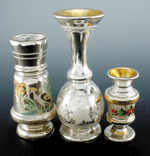
Left & Right: NaĂŻve hand painted vases; center: bulbous vase, gold washed
interior, some wear to
silvering. Bohemia, circa 1860-80.
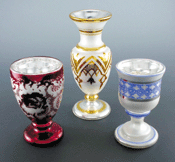
Rare colored Bohemian mercury glass, circa 1860-80. Top: Satin matte ground
and intaglio gold flashing engraved to silver;
right: satin matte ground with
rare blue coloration banding; left: rare and traditional "forest" decoration,
ruby casing cut to silver.
|